Having finished with my speedy sightseeing of the city of As-Salt on account of the limited time, I went to the car where the driver waited for me. Meanwhile, the Sun had started to set behind one of the surrounding hills, while the museum was already closed.
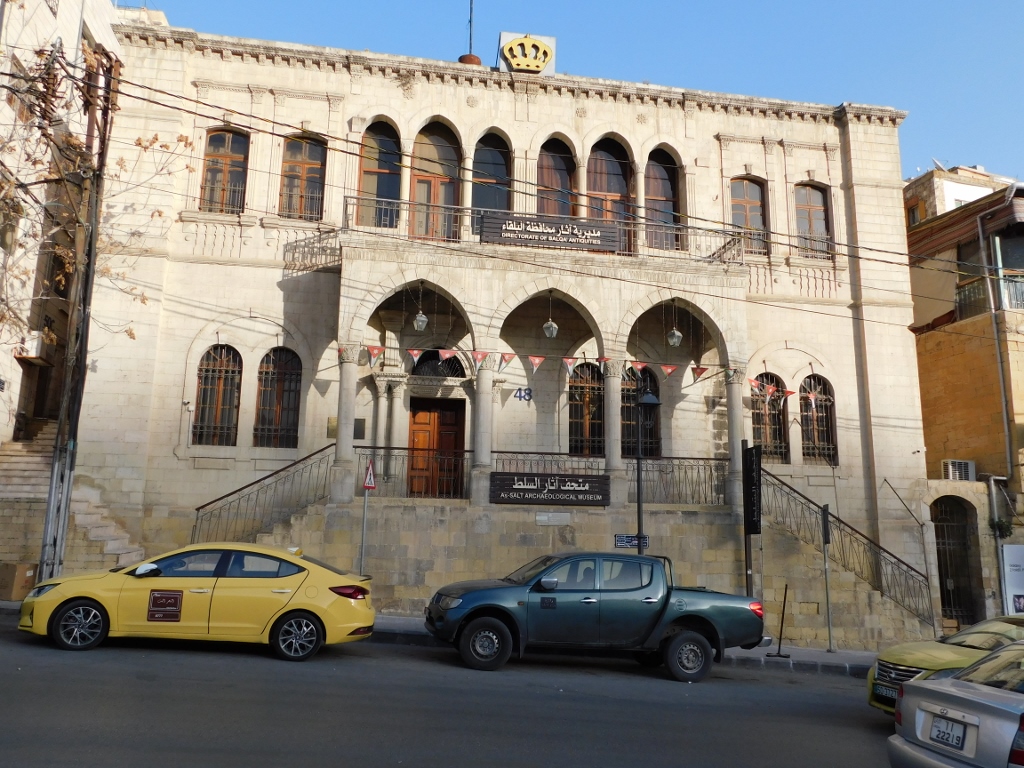 Salt Archaeological Museum
Salt Archaeological Museum
Still, we did not leave right away since I realised I was hungry, so I went to a nearby place for local fast food in order to buy something to eat.
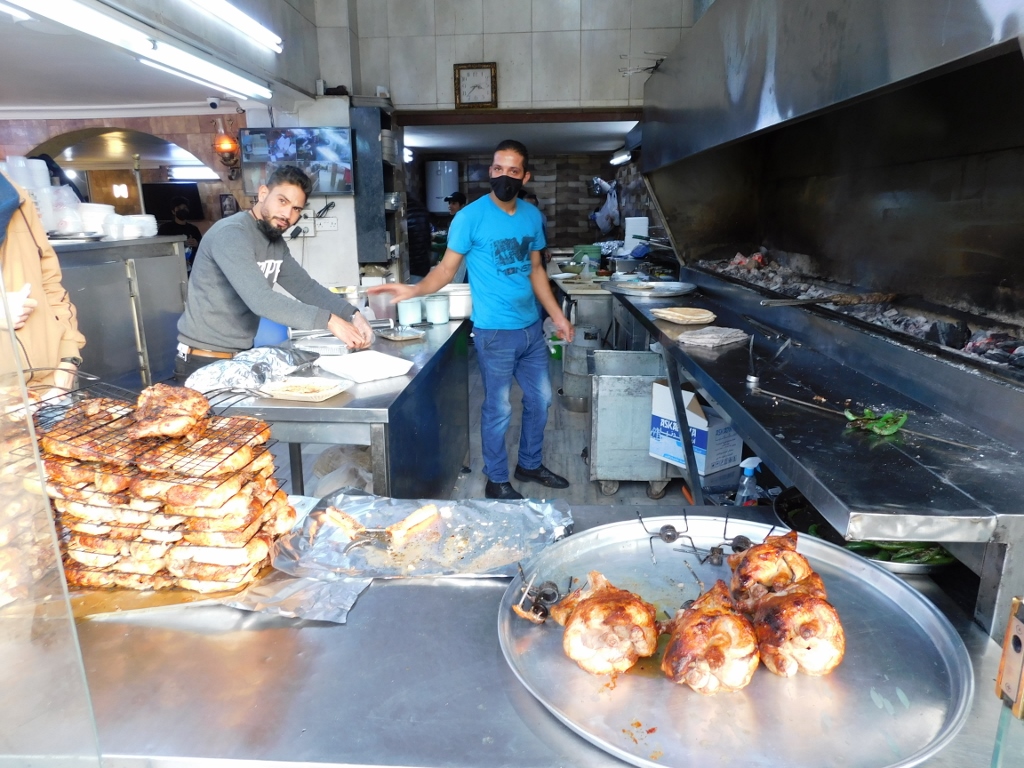 Fast food restaurant in the centre of As-Salt
Fast food restaurant in the centre of As-Salt
Although the roasted chicken on the front metal table seemed very tasty, I was not sure this would be easy for me to eat in the car, which was the basic plan. So, I opted for ara’yes. This is a typical dish – two round raw dough flatbreads and in between meat, onion, parsley and seasoning, which is all together then put on the grill.
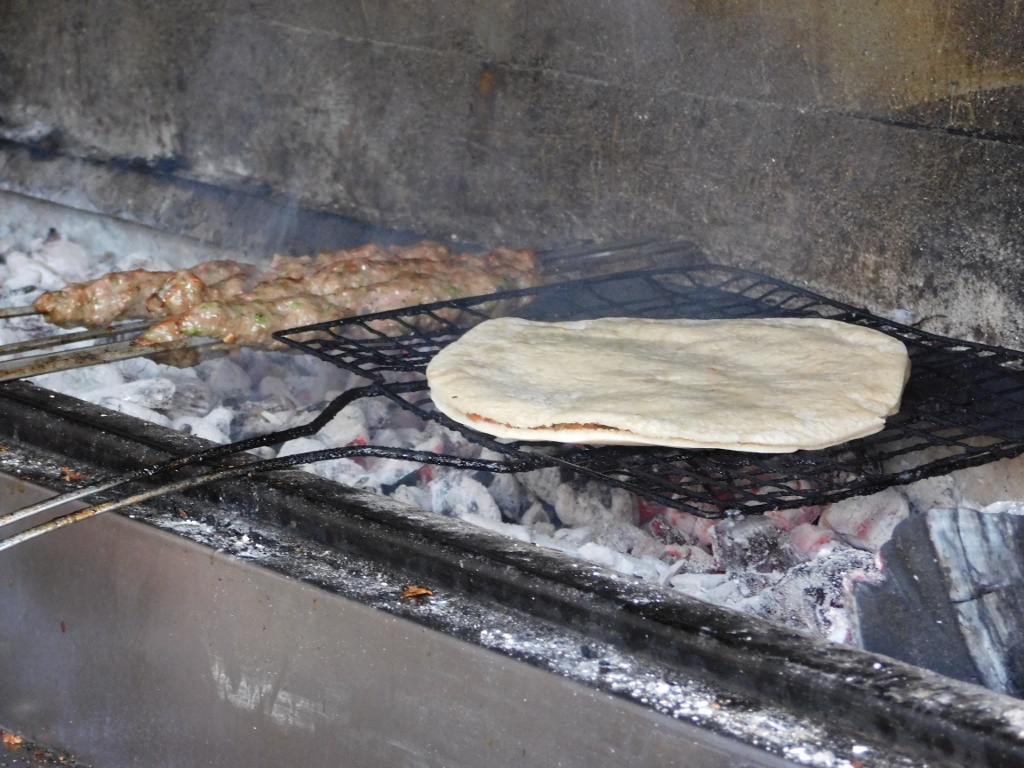 My ara’yes is starting to grill
My ara’yes is starting to grill
While I was waiting for my food to get ready, I used the opportunity to take photos of some nearby houses, also from the Ottoman period, as well as of Al-Qal’a hill. The second photo below shows the beginning of the souk, Hammam street filled with shops, as well as a minaret of a smaller mosque in the centre of the city.
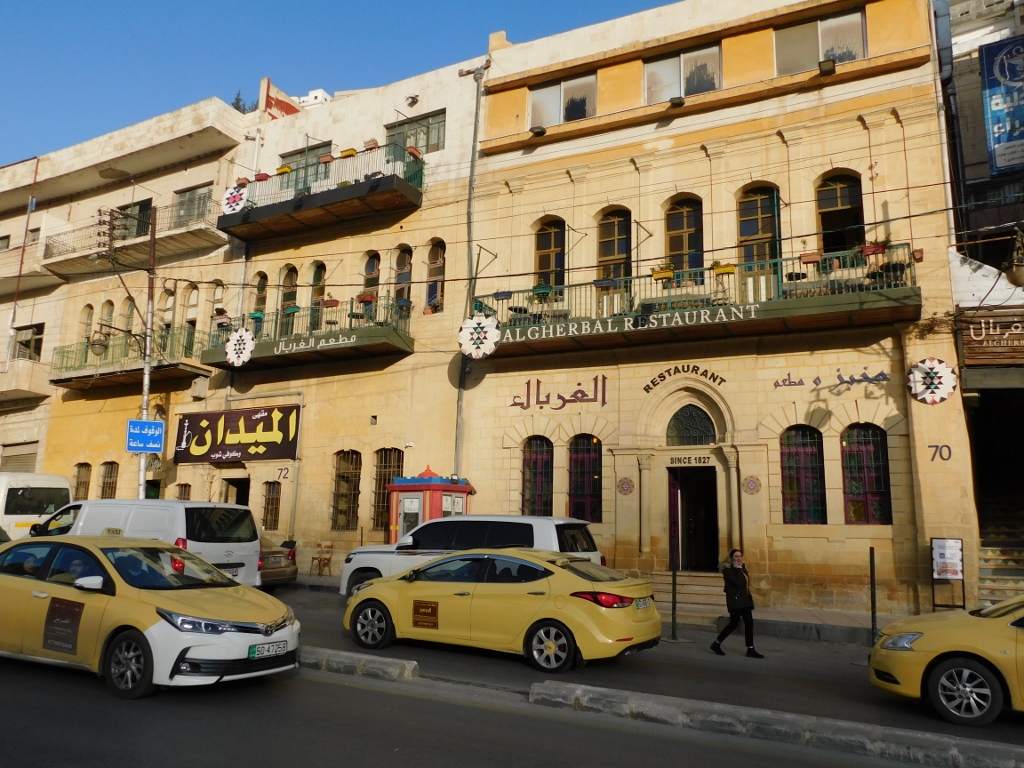 As-Salt
As-Salt
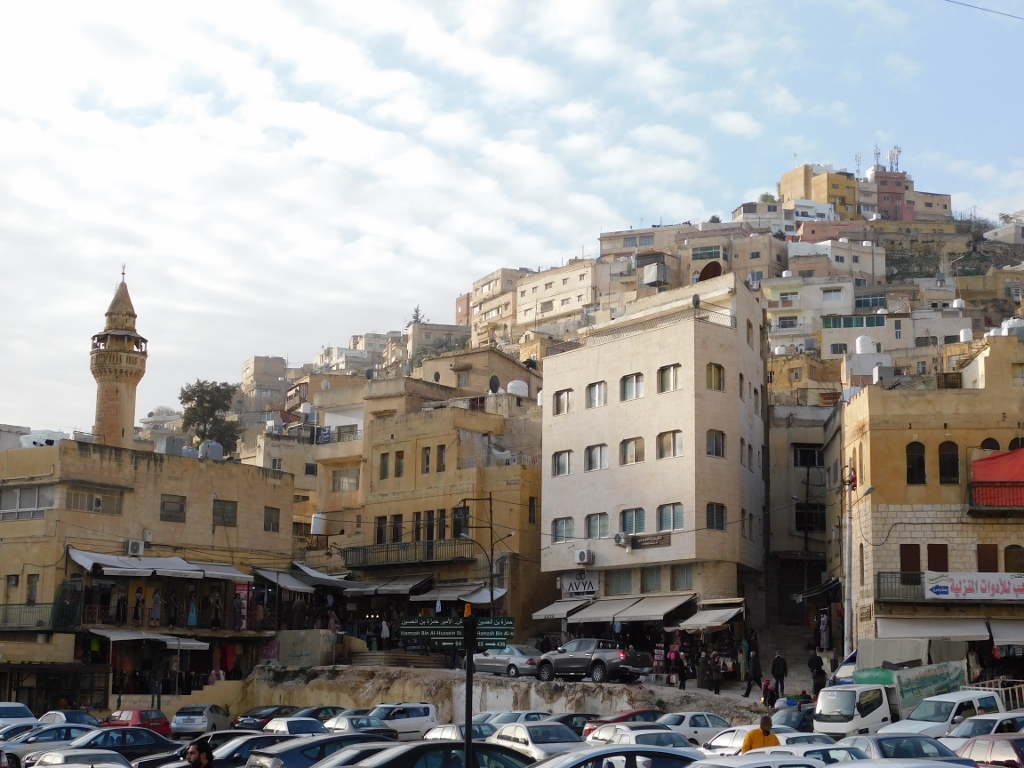 Al-Qal’a Hill
Al-Qal’a Hill
When my food was ready, I got everything they packed up for me, which meant that along with ara’yes I also got several pickled pieces of vegetables that really went well with the main food. It was only then that I realised how hungry I actually was. Once I had devoured the food, I could relax, sit back and look at the world around me. And so I noticed a picturesque motorist.
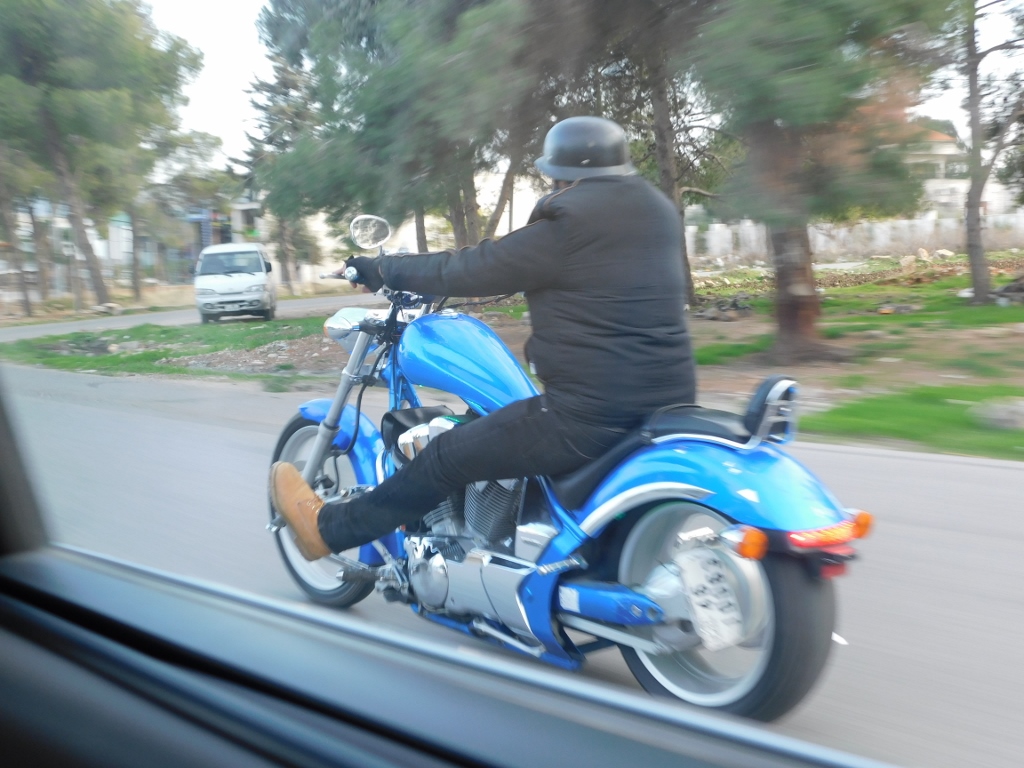 A sight from the road
A sight from the road
Upon my return to Amman, I rested in my hotel room for a short while and then I decided to go for a walk. The kind couple I met in Al-Maghtas recommended that I should go to a part of the city that was in fact quite close to my hotel in Amman, saying that there were lots of restaurants and cafés there. This part of Amman is called Jabal al Lweibdeh. Need I mention at all that “jabal” means – hill, while the part with restaurants is on the very top? This was a half an hour walk, but it entailed once again some very steep steps and some very steep parts of the streets. Still, I got where I wanted to and had a nice fruit cocktail in one of the cafés. But I did feel tired and did not stay there for long, wanting to get back to the hotel and go to sleep a little earlier.
The return felt easier and I even remembered to take a few photos.
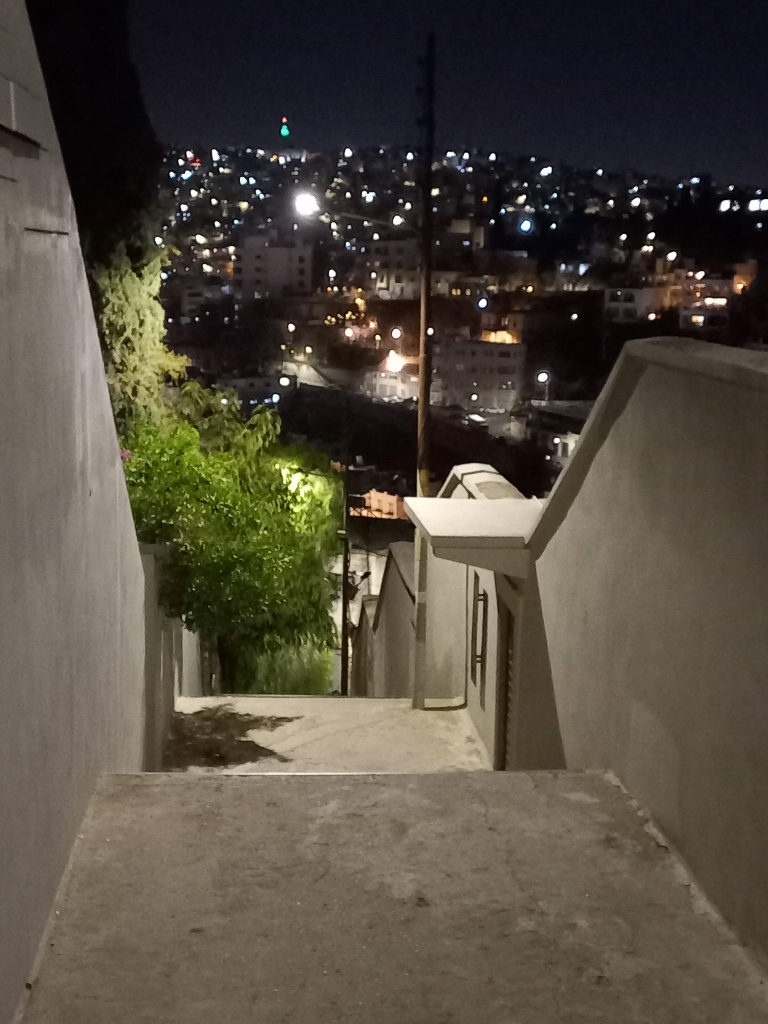 Amman, pardon, the stairs – at night
Amman, pardon, the stairs – at night
But, before returning to the hotel, I wanted to try some sweets. First I stopped at a shop that offered different versions of cookies and biscuits. Some of them were precisely what I was offered by those Jordanians during the joint sightseeing tour. Now I decided to buy a smaller quantity that I could take back to my room so that I had a small supply for the next couple of days. My favourites were maamoul cookies that are made in different shapes, but the essence is the same – pastry filled with date paste, and barazek biscuits – crunchy biscuits with chopped pistachios on the bottom and sesame seeds on the top.
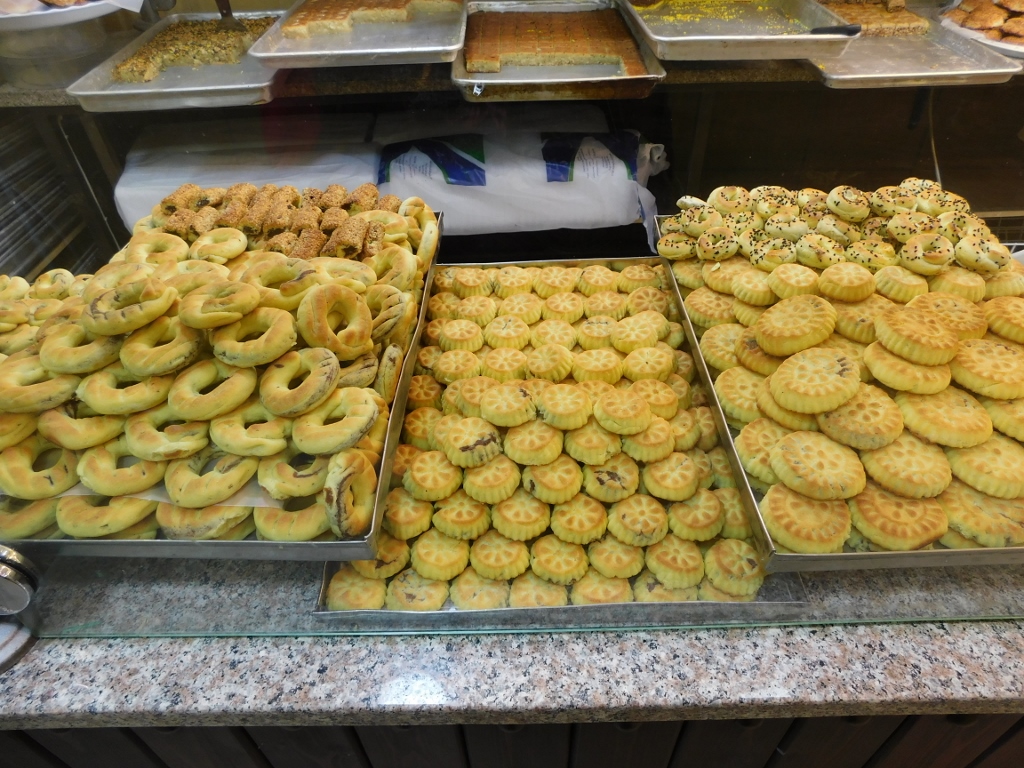 Maamoul cookies
Maamoul cookies
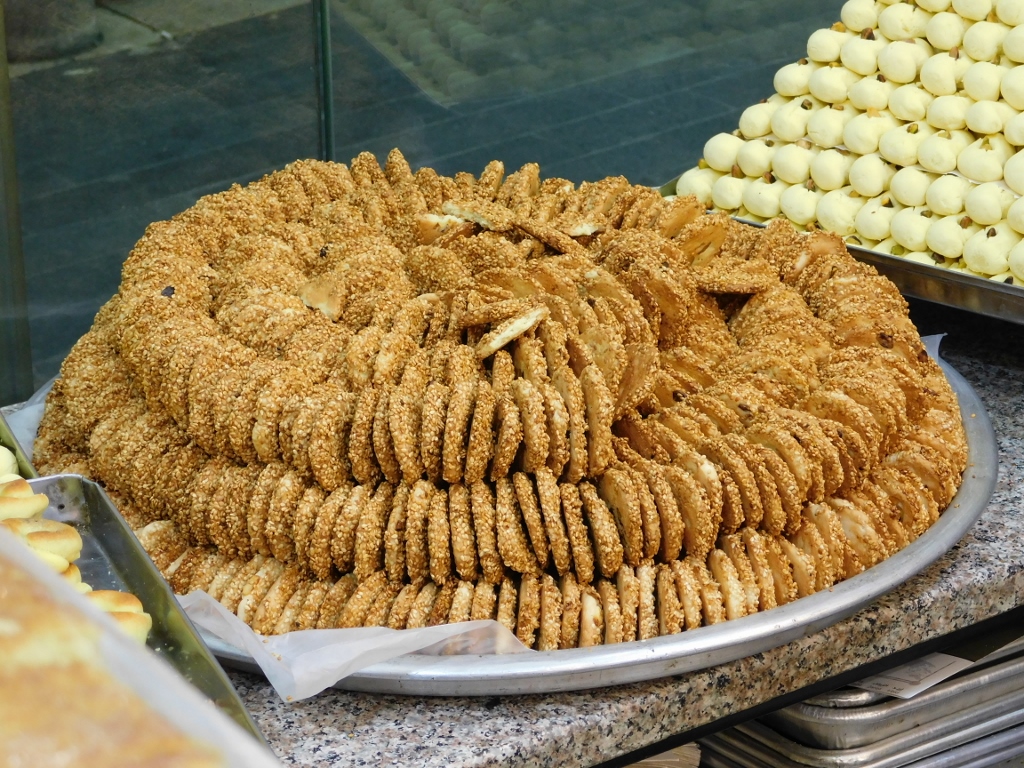 Barazek biscuits
Barazek biscuits
But, the main sweet in Jordan is – kunafa or knafeh. So, this was what those Jordanians recommended to me at the very beginning and later, during my travel, when somebody asked me what I liked in Jordan in terms of food I would immediately say with unhinged delight knafeh and they were not only pleased to hear it, but could also relate to it. This sweet is so popular in Amman that I could not believe it. And mostly the one made at a famous sweet shop. In fact, this is a big and locally well-known company “Habibah” that has its shops throughout the city, including the downtown area of Amman. Already the first evening, when I went to eat falafels in “Hashem” restaurant, I passed by a small alley where I saw a major crowd and lots of people waiting in line. I had no idea what this was about and did not deal with it at all, going rather my way. However, this evening I realised that all those people were waiting in the line in order to buy a portion of – knafeh!
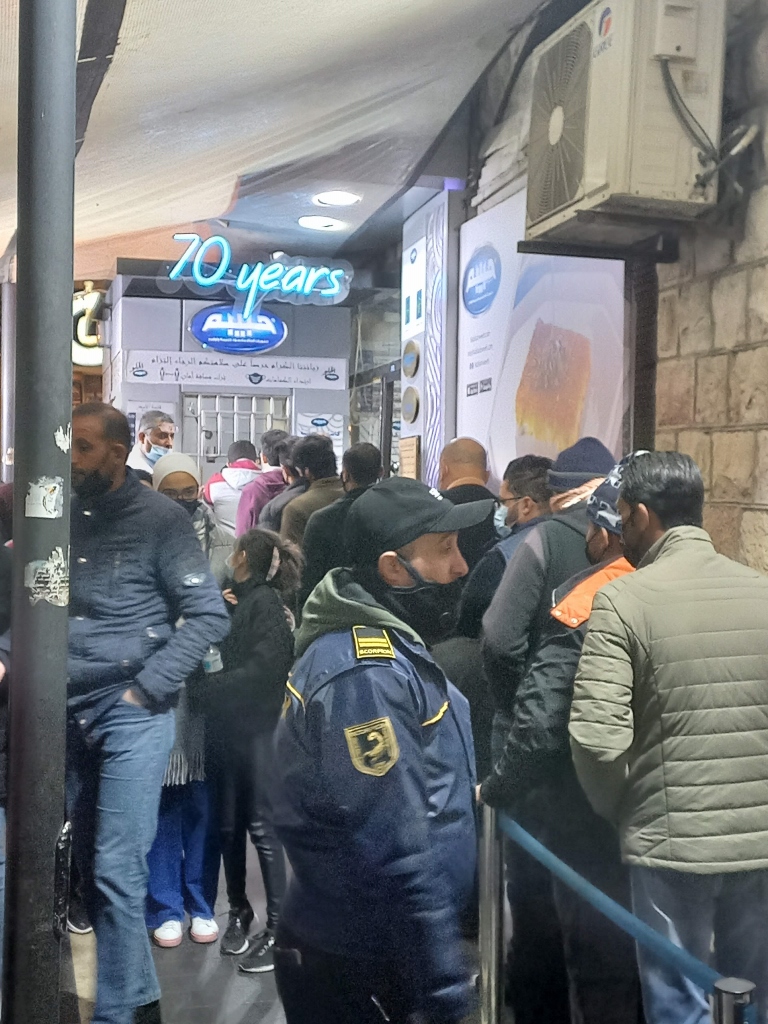 Line of people waiting for knafeh
Line of people waiting for knafeh
In the photo above, under the sign 70 years, you can see their logo (white text against the blue background, all within an ellipse shape), so, whoever goes to Jordan and Amman should look for it. The way to buy knafeh is as follows: you get in the line (there is ALWAYS a line, whenever I came here there were people in the line), then you get to the cashier, say “knafeh” and show with your hands smaller or bigger, and then you pay and get a receipt. With that receipt in your hands, you enter a narrow space within the shop, hand the receipt to the guys working there and they put a piece of knafeh, served warm, onto a Styrofoam plate and you get a plastic spoon as well. Then you get out and in the company of numerous people eat your sweet. I worried about such ample use of Styrofoam plates and single-use plastic spoons, but this was the local custom and so I duly ate my portion, throwing the packaging, like everybody else, into a bin placed nearby for the purpose.
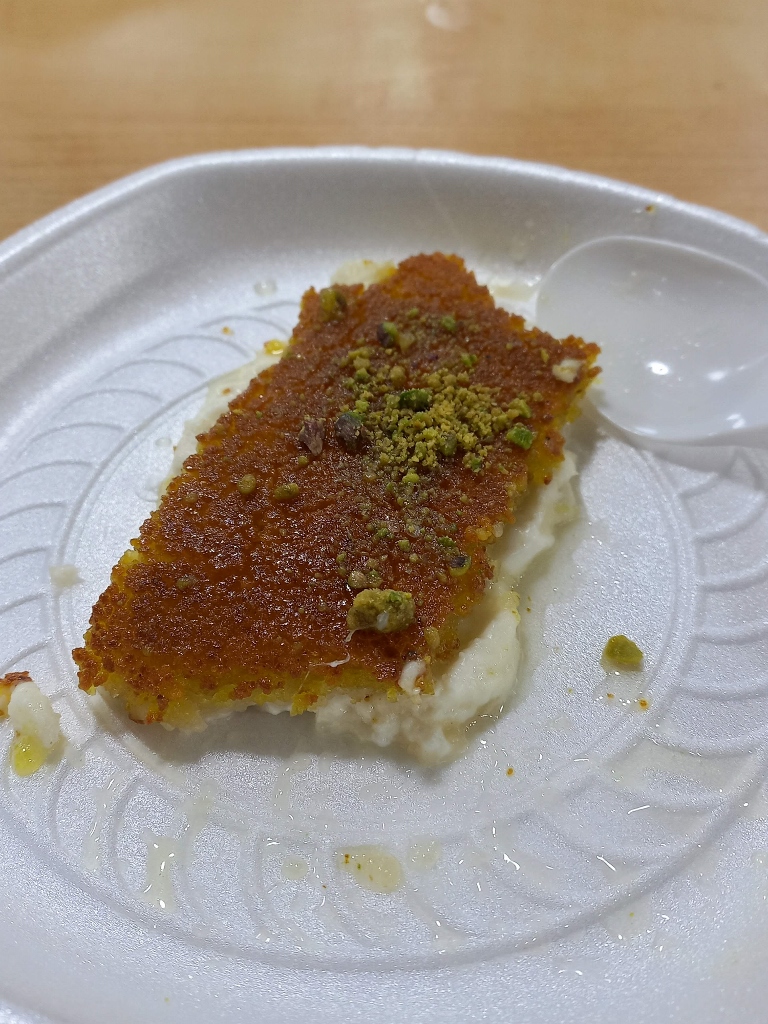 Half-eaten portion of knafeh
Half-eaten portion of knafeh
But, let me go back to the sweet. To put it simply, this is made from a layer of cheese with a layer of thin spun pastry, kataifi. This is then baked, covered in ground pistachios and drenched with ample quantity of sugar syrup. It is served warm.
Although this is a very popular sweet in Jordan, as well as throughout the entire Arab world, it is considered a Palestinian recipe. The same thing could also be said for barazek biscuits that originate from Damascus, i.e., from Syria. Moreover, during my journey here, someone told me that the best sweets, as well as the best sweet makers come from – Syria. But, the entire Near East (Levant) is a cultural melting pot, so this is no wonder. On the other hand, whoever came up with these recipes or makes them, these sweets are spectacular. From this moment on, every evening I spent in Amman I went for a portion of knafeh – after all, I had to make up for all those calories used by the incessant climbing.
And yet, no matter how much I liked the knafeh, I didn’t even think of trying to make it at home. It just seems too complicated, but I did try making some other sweets and here are the results and the recipe for one of them:
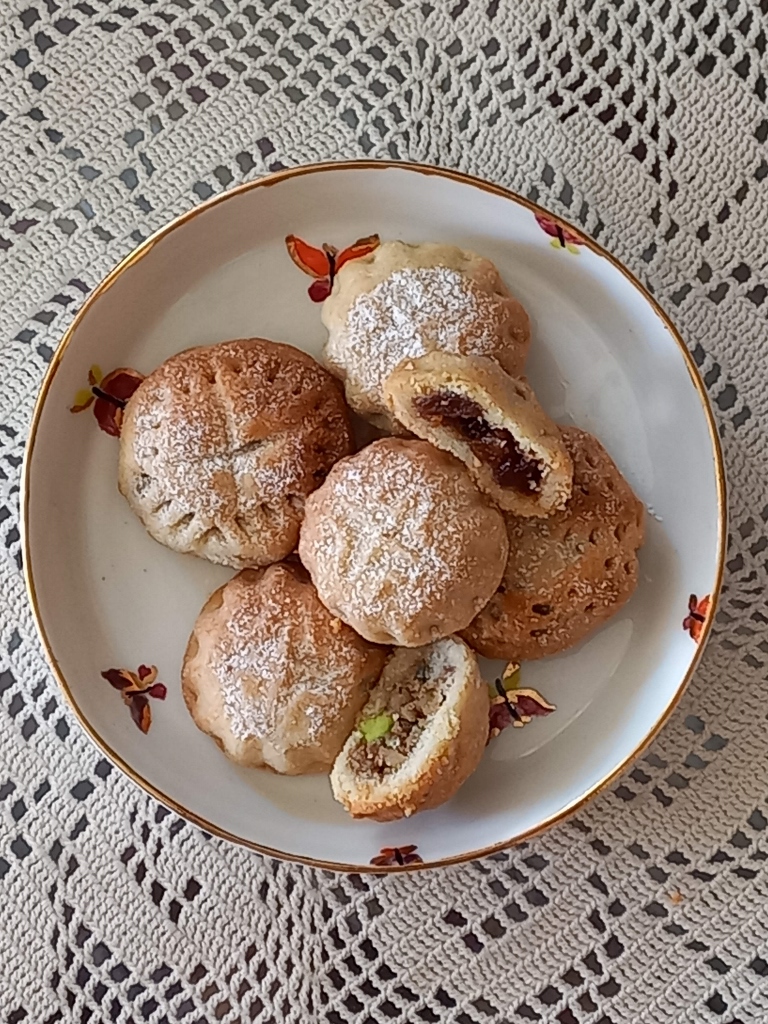 Maamoul served on a porcelain plate which I made myself
Maamoul served on a porcelain plate which I made myself
MAAMOUL
- 350 g semolina
- 125 g flour
- 1 Tbs of mahleb, an oriental spice (you can also use cinnamon or vanilla sugar)
- a pinch of salt
- 250 g butter
- 80 ml warm milk
- 2 Tbs of sugar
- 1/2 tsp of dry yeast
- filling made of dates or mixed dried fruits or nuts
In the evening, mix the semolina, flour, spice and salt, and then pour melted butter over it and mix it all well by hand in order to be sure that everything got incorporated well. Leave it in the fridge over night.
The next day, first take the mixture out of the fridge and leave it at room temperature for as long as necessary in order for the butter from the mixture to soften. Then put the yeast and the sugar into the milk and leave for a couple of minutes to froth and then join it with the semolina and flower mixture. Knead it all well by hand in order to get soft dough.
There are special moulds for maamouls, but the cookies can also be decorated in different ways by using a fork, for instance. So, take a small piece of dough, flatten it and then put some filling into the middle. Wrap the filling with the dough and roll this between your palms to get a small dough ball with the filling in the middle. Flatten the ball and make some kind of pattern and then arrange it on a baking tray. Bake for 10-15 minutes at 180 degrees C.
As far as the filling is concerned, I used a mixture of dried fruits that I had already made for some other sweets, but the recipe was rather complicated and surpasses the level of my travel blog. But, here is a simple recipe for a nut filling: 150 g of walnuts (you can also make a mixture with pistachios, hazelnuts or almonds), 1 Tbs of powdered sugar, 1 Tbs of honey and 1/2 Tbs of melted butter. You can also add some cinnamon. Mix it all and grind it in one of the contemporary kitchen appliances.
But, let me go back to Jordan and Amman. Very content and with my stomach full, I went back to my hotel room and went to sleep rather early. The next morning I was greeted by cloudy weather, rain and a rather strong wind. Still, that did not prevent me for wanting to do some sightseeing. Since I had already seen the weather forecast, my plan was not to go outside Amman, but to visit some places within the city itself.
And so, after the breakfast, I caught a taxi and went... where else, but to the top of a hill. This time, it was Jabal Al Qala’a. The name in Arabic discloses what this is all about – a citadel hill. Although this hill rises literally right from the hotel in which I stayed, I simply did not have the stamina to climb the surrounding slopes. After all, my right knee started to hurt the night before. This morning, I felt no pain whatsoever, but I said to myself that I should spare my legs, since I would need them later on. Before entering the Citadel site, I took photos of some parts of Amman that can be seen from that hill.
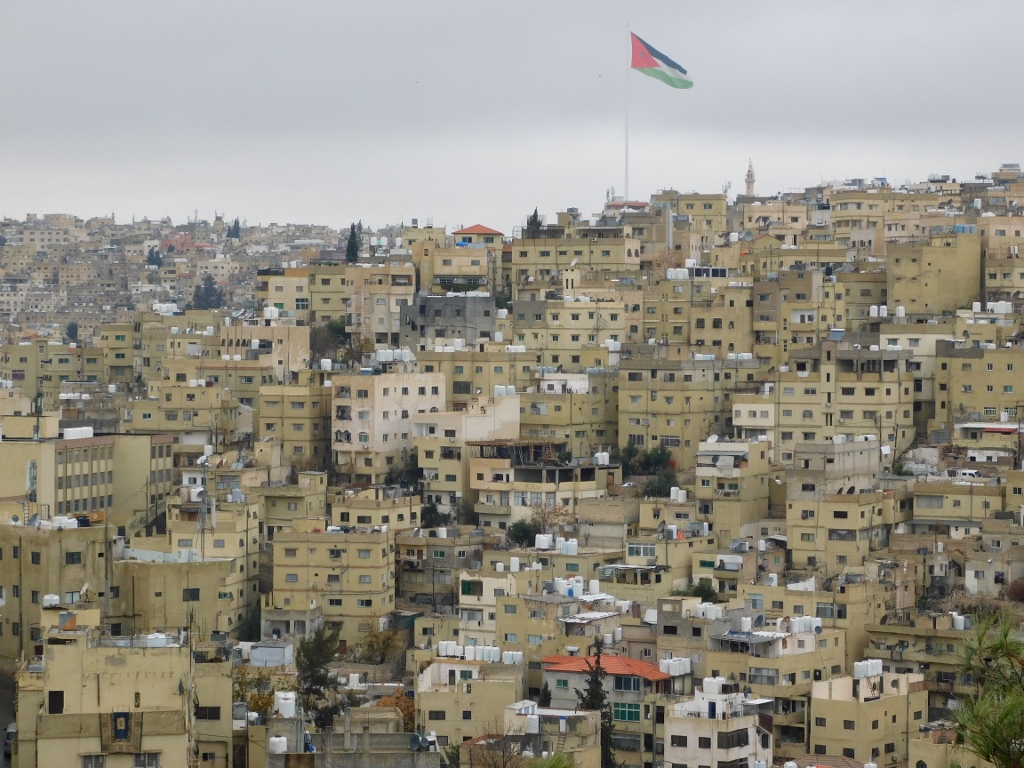 Amman
Amman
Then I bought a ticket and entered the Citadel site that occupies the entire top of the hill, like a spacious plateau, mostly flat.
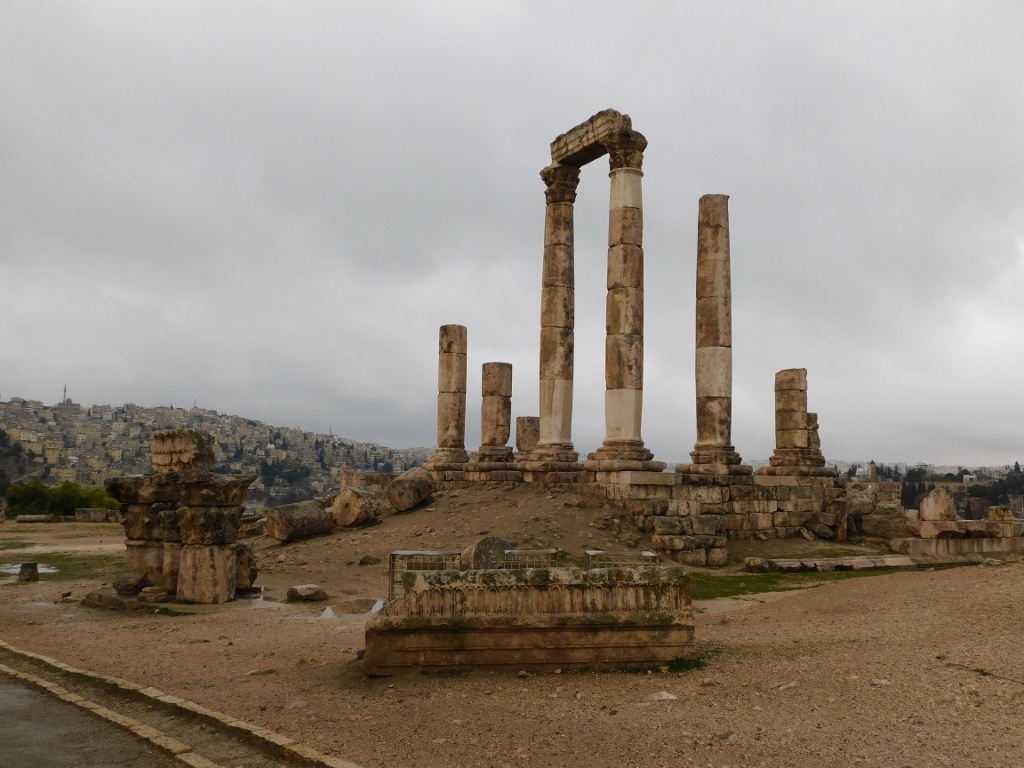 Amman’s Citadel: remains of the Temple of Hercules
Amman’s Citadel: remains of the Temple of Hercules
Let me just mention that the rain that had poured earlier that morning was rather symbolic by this time.
So, in this area, archaeologists have discovered traces of settlements and fortifications that are believed to have been built some 7000 years ago, more or less at the time of the onset of the civilisations in Mesopotamia and the Nile valley. After the prehistoric period, there was a succession of the Persian, Hellenistic, Roman, Byzantine and Arabic and Muslim influences.
In addition to the impressive remains from different periods, the first National Archaeological Museum is also located here.
The first place I visited was the remains of a Byzantine church from the 6th century.
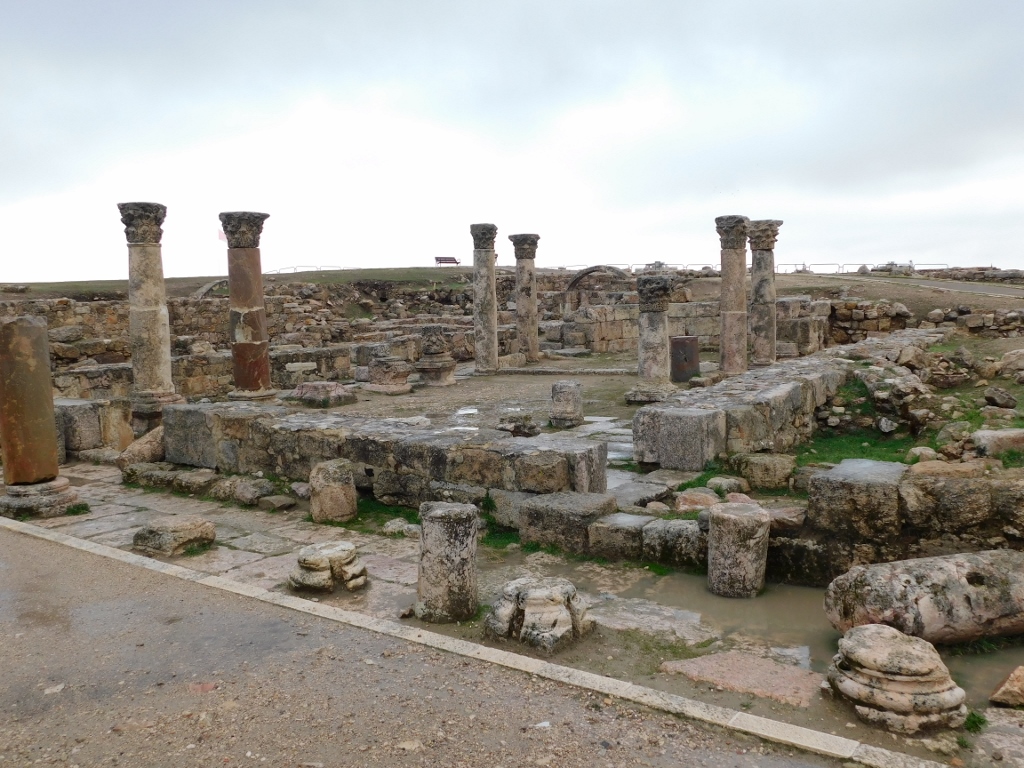 Byzantine church within the Citadel
Byzantine church within the Citadel
The church follows the basilica plan, with a naos and two aisles, ending on the east side in a semi-circular apse. The Corinthian capitals used for the church were taken from the nearby Temple of Hercules, while the floor of the naos was traditionally decorated with a mosaic. Today, the mosaic is not seen, since it is covered in order to be protected.
Going farther, I spotted a building that had an impressive blue dome, so I headed that way.
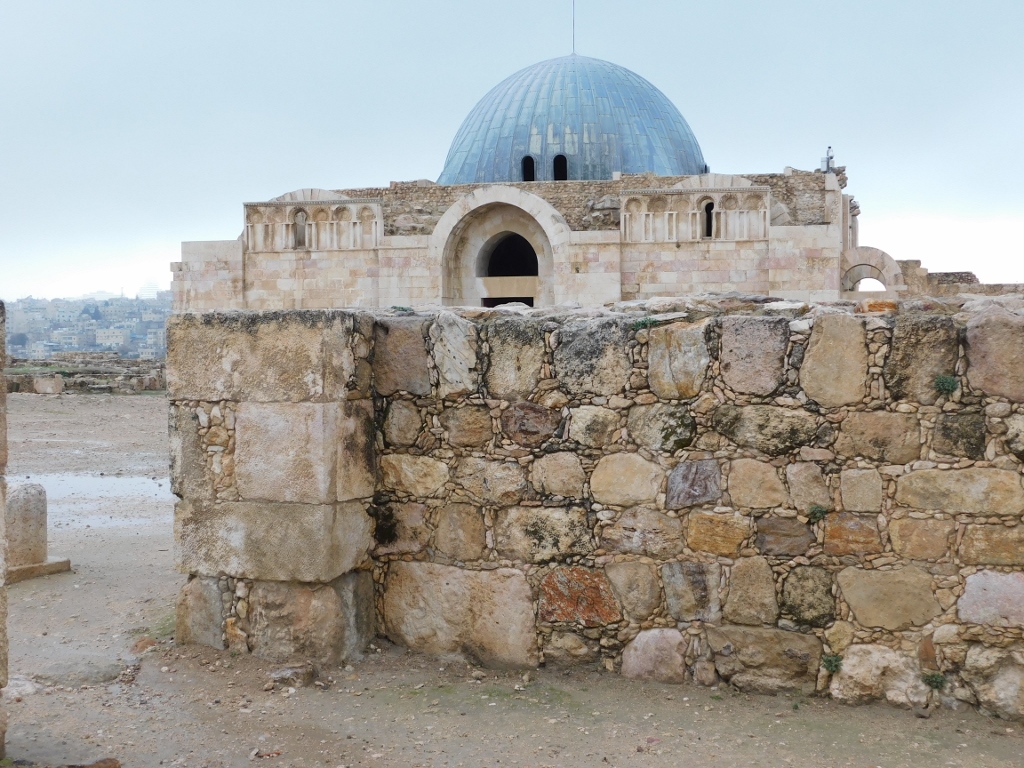 Wall and behind it a part of the Umayyad Monumental Gateway
Wall and behind it a part of the Umayyad Monumental Gateway
I was so impressed with this building, that in fact I did not take any frontal photos of it at this moment; I was just drawn to it. But, I did correct this a little later on, so here is that photo.
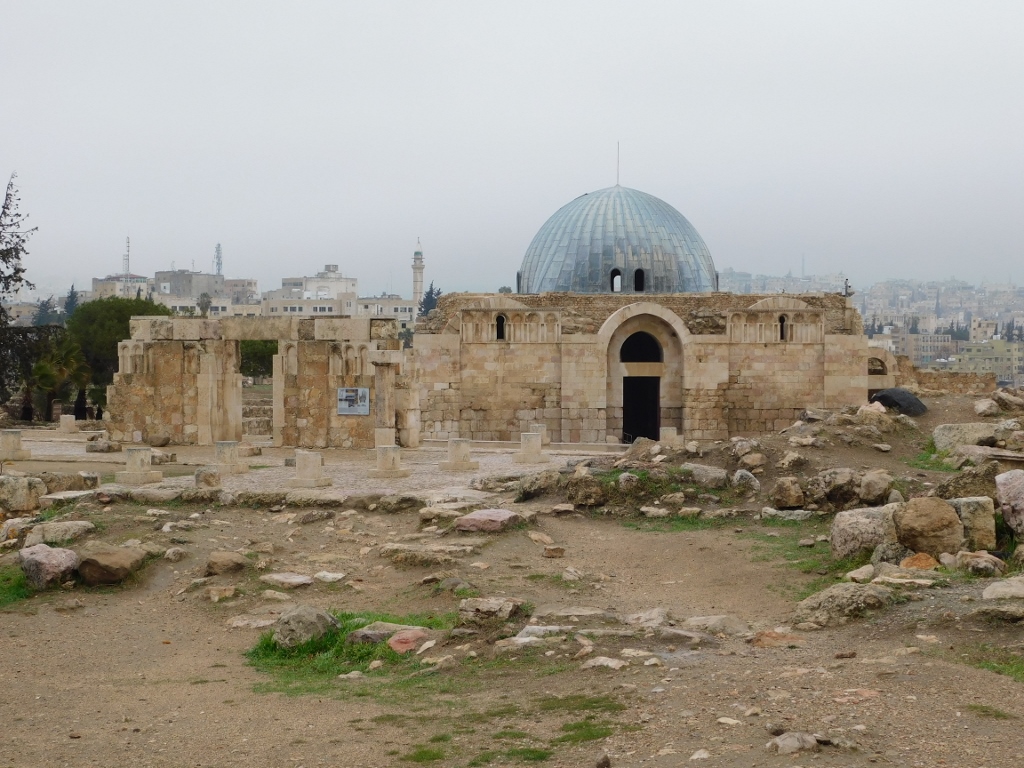 Remains of the Umayyad mosque (left) and the Umayyad Monumental Gateway (right)
Remains of the Umayyad mosque (left) and the Umayyad Monumental Gateway (right)
This is a restored and reconstructed monumental gate leading to the Umayyad palace. But, let me first say a few words about the Umayyad Caliphate. The Umayyads were the first dynasty (661-750) that ruled after the Rashidun Caliphs, but they are also the second caliphate (there were four of them in total, while the period under the Rashidun Caliphs (four caliphs) is deemed the first caliphate (632-661)). I don’t want to expand the whole story now, but I do have to mention that these four (Rashidun) caliphs ruled right after the death of Prophet Muhammad. The Sunni Muslims recognise all four of them and call them the “rightly guided,” while the Shia Muslims believe that the first three of them were usurpers. The problems that today can be clearly seen within the Islam date back to these times, i.e., to the period directly after the death of Prophet Muhammad.
In any case, after these four caliphs, the first next ruler introduced the right to the throne by succession and not by election/appointment, establishing in this way a dynasty, the Umayyad one to be precise. The Umayyad dynasty lasted for 90 years and it comprised 14 rulers. During this period, there were a lot of negative, as well as a lot of positive developments, and one of the more significant ones was the large territorial expansion and we can already talk about the Islamic Empire here. In addition to the Arabian Peninsula, the territory of the present-day Near East and north from there, Persia and further to the east, the Umayyad Caliphate also included the north part of Africa, as well as parts of Europe – the Pyrenean Peninsula and parts of the present-day France.
Here in Amman, within the Citadel, one can see remains from the period when the Umayyad dynasty ruled and one of the structures is this Monumental Gateway. The gateway was built on top of the remains of an older, Byzantine structure (from the 4th-5th century) and it was used as the formal gateway to the palace. It has a cruciform plan, precisely because the foundations of the Byzantine building were used. The north and the south arms of the cross are covered by barrel vaults, while the east and the west arms have semi-domes. It is believed that the central section had a wooden roof in the shape of a dome, just like the one seen today made towards the end of the 20th century. In addition to this dome, partial reconstruction was also done on this building and this can be seen nicely on the left and the right sides of the south passage through which one enters.
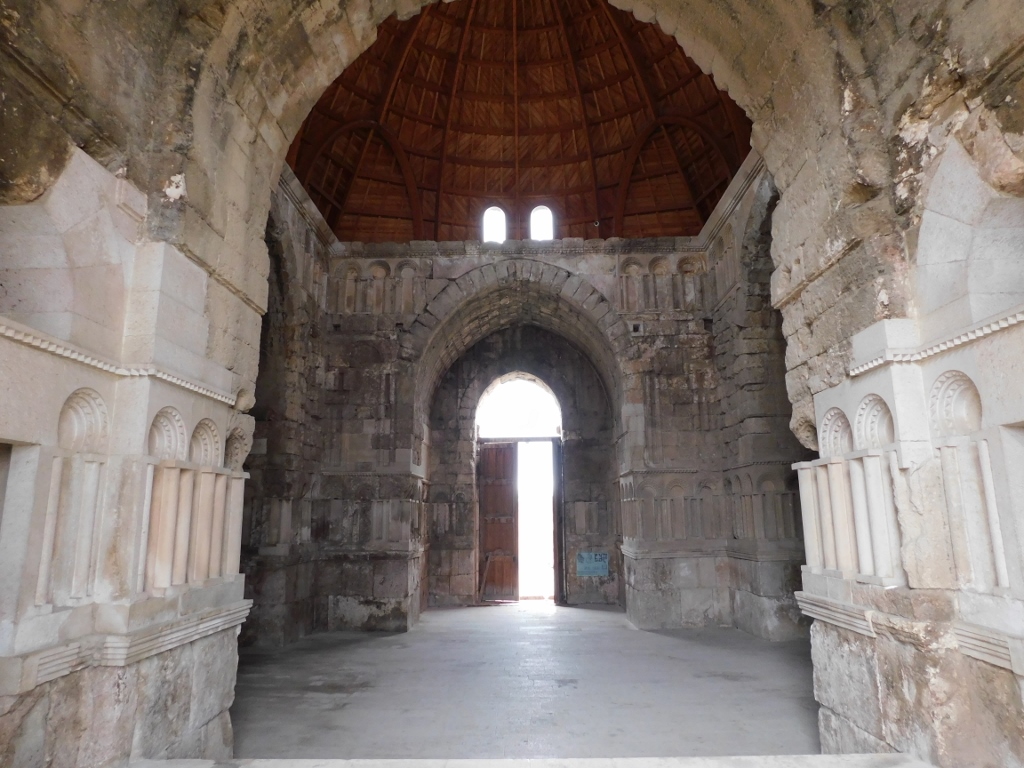 Umayyad Monumental Gateway, the entrance
Umayyad Monumental Gateway, the entrance
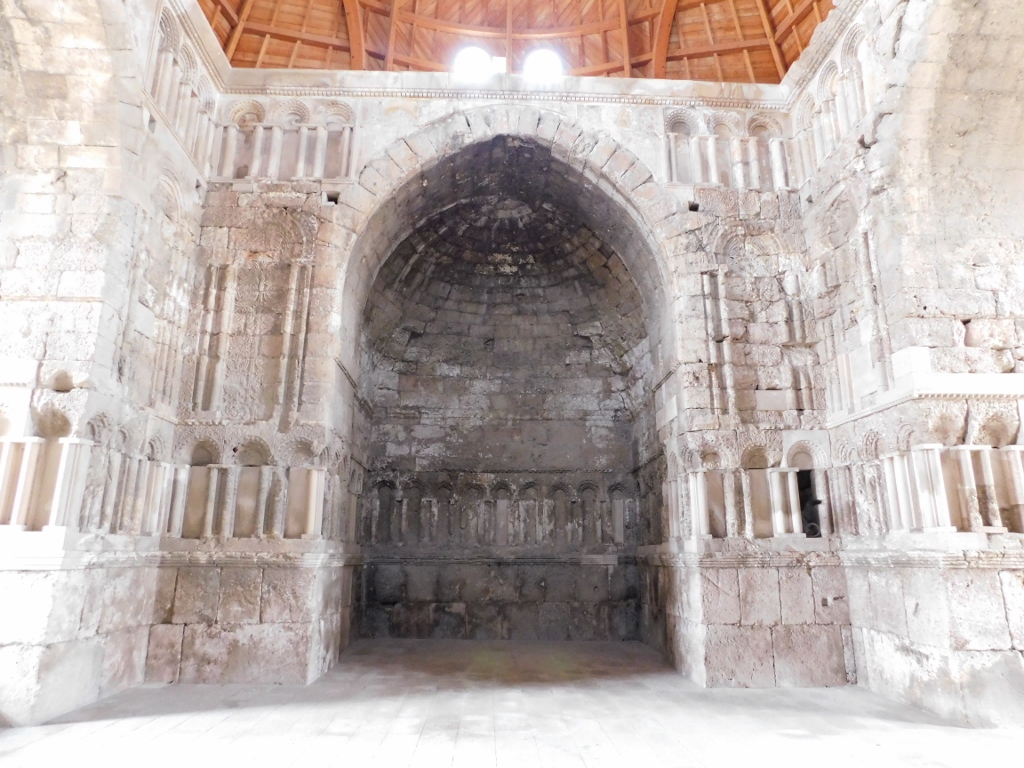 Umayyad Monumental Gateway, western arm
Umayyad Monumental Gateway, western arm
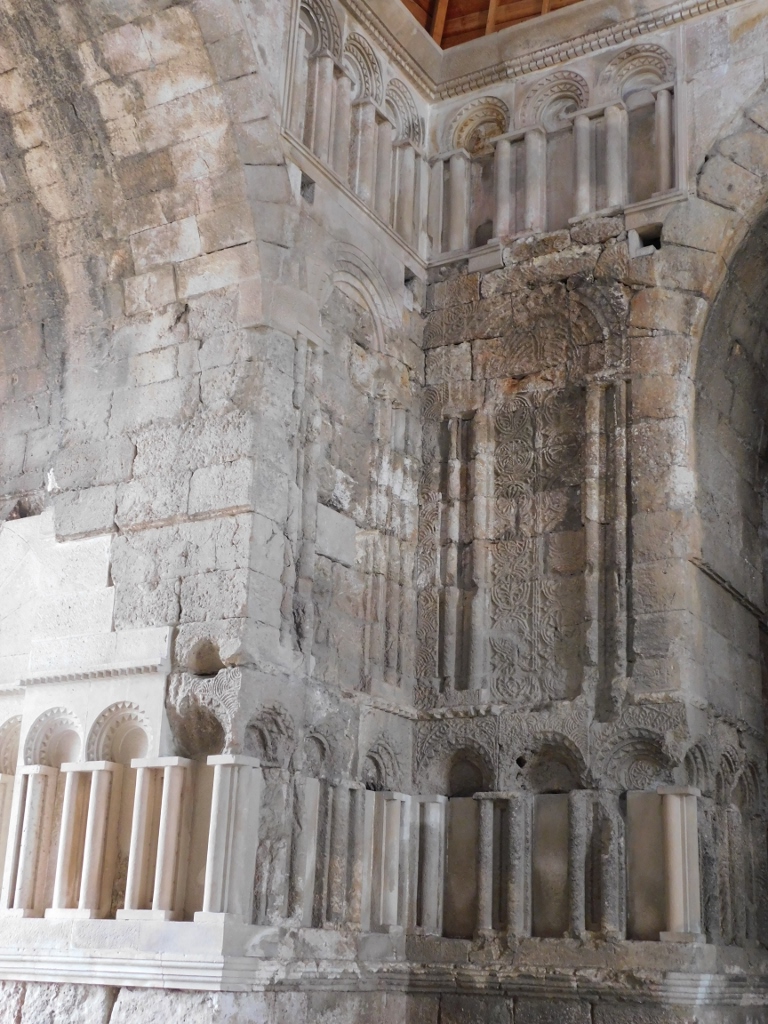 Umayyad Monumental Gateway, decoration in the southwest corner
Umayyad Monumental Gateway, decoration in the southwest corner
However, once you go through the Monumental Gateway, you will need much more imagination to picture what it all may have looked like once, but bearing in mind the gateway you can certainly presume it was impressive.
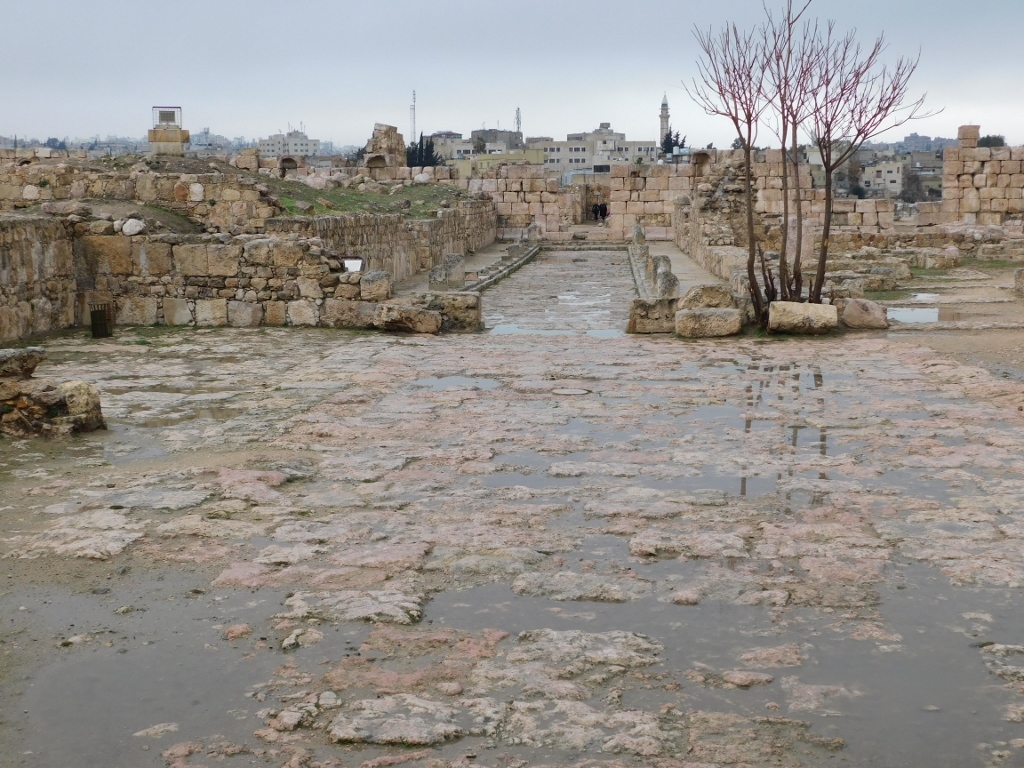 Remains of the Umayyad palace
Remains of the Umayyad palace
Within the remains of the palace, archaeologists have revealed parts which were used as administrative and residential premises, and bath houses, while in the centre there was the Audience Hall and Throne Chamber. It is important to bear in mind that Amman was the capital of a province during the Umayyad Caliphate, so this was the residence of the governor, not the caliph (most of the time the capital was Damascus). Also, although this area was used in the later periods (from the 8th to the 12th century), it is believed that most of the palace was never restored after a devastating earthquake from 749. By the way, these periods when the area was used after the earthquake were the periods of the third and the fourth caliphates – the Abbasid and the Fatimid Caliphates.
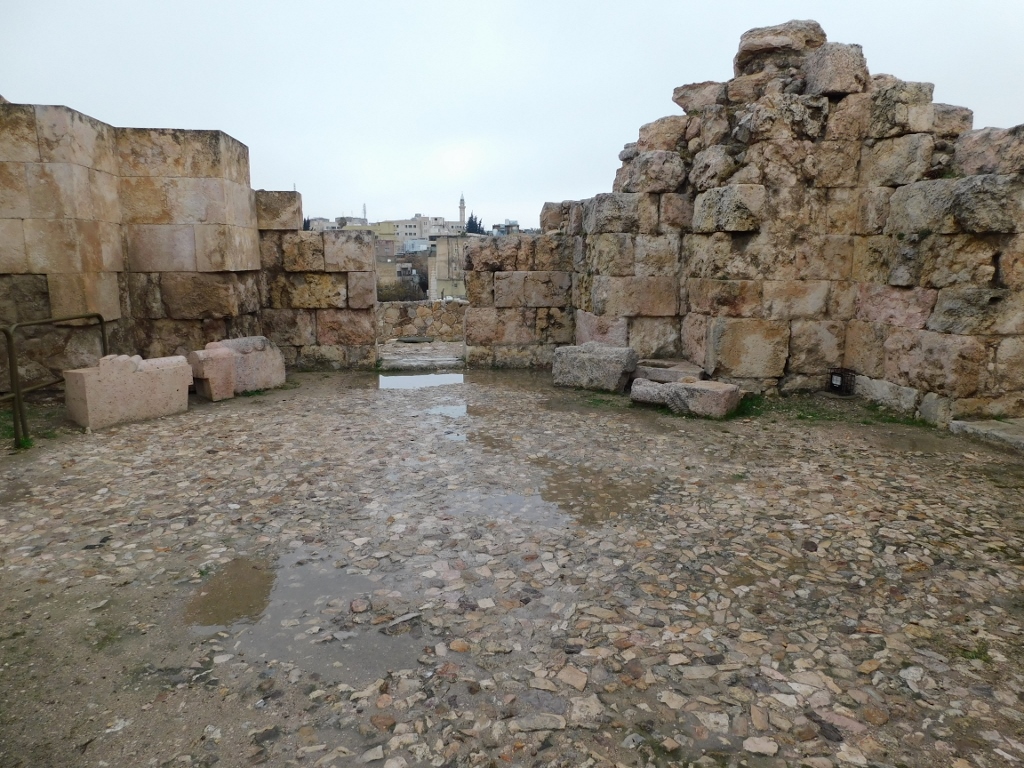 Remains of the Throne Chamber
Remains of the Throne Chamber
After this, I started to go back following the exterior sections of the former palace and there I passed by remains of the residential quarters from where I had a lovely view at the Monumental Gateway.
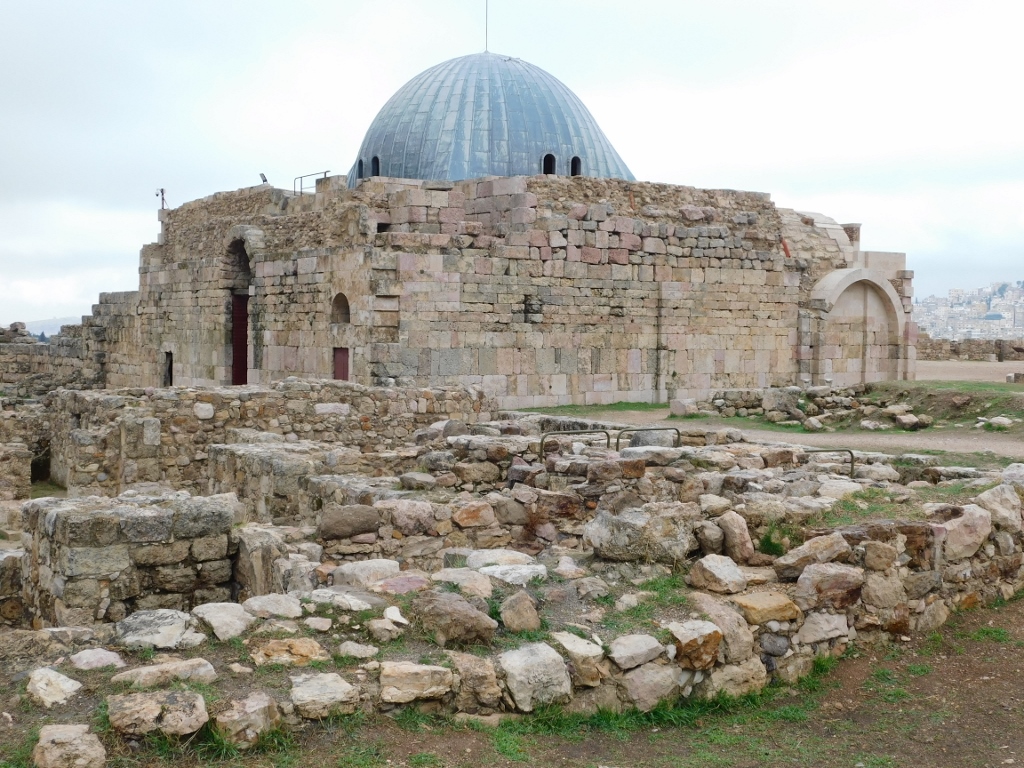 Remains of the former residential quarters and the Monumental Gateway
Remains of the former residential quarters and the Monumental Gateway
And then I got again to the empty space in front of the gateway which was in fact the ancient courtyard. From there it is possible to see nicely the entrance into the Monumental Gateway and the remains of the Umayyad mosque on the opposite side of the courtyard, which I took a photo of from the direction of the remains of the Umayyad market place or souk.
 Monumental Gateway (left), the courtyard in the middle, stairs leading to the entrance into the mosque and the remains of the Umayyad mosque (right)
Monumental Gateway (left), the courtyard in the middle, stairs leading to the entrance into the mosque and the remains of the Umayyad mosque (right)
The mosque was built on a platform south of the palace around 730 CE. Little has survived to date, but there is still a part of the front wall.
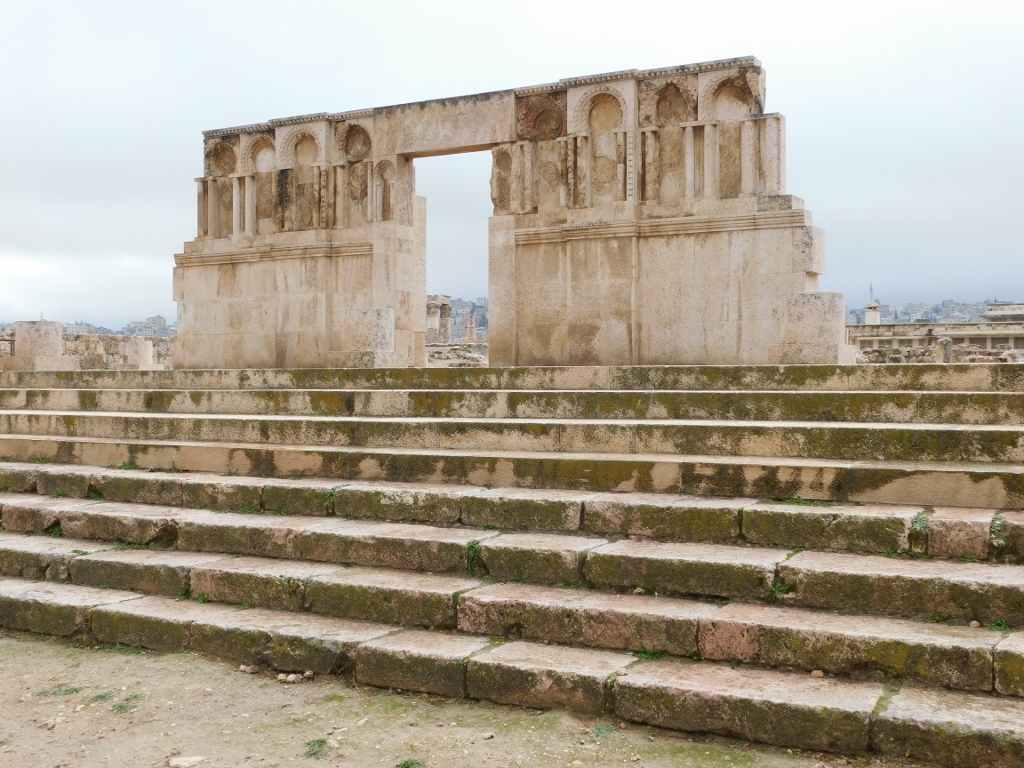 Remains of the Umayyad mosque
Remains of the Umayyad mosque
In the area that was once the interior of the mosque, you can see the relatively modest remains of this building that originally must have been very impressive.
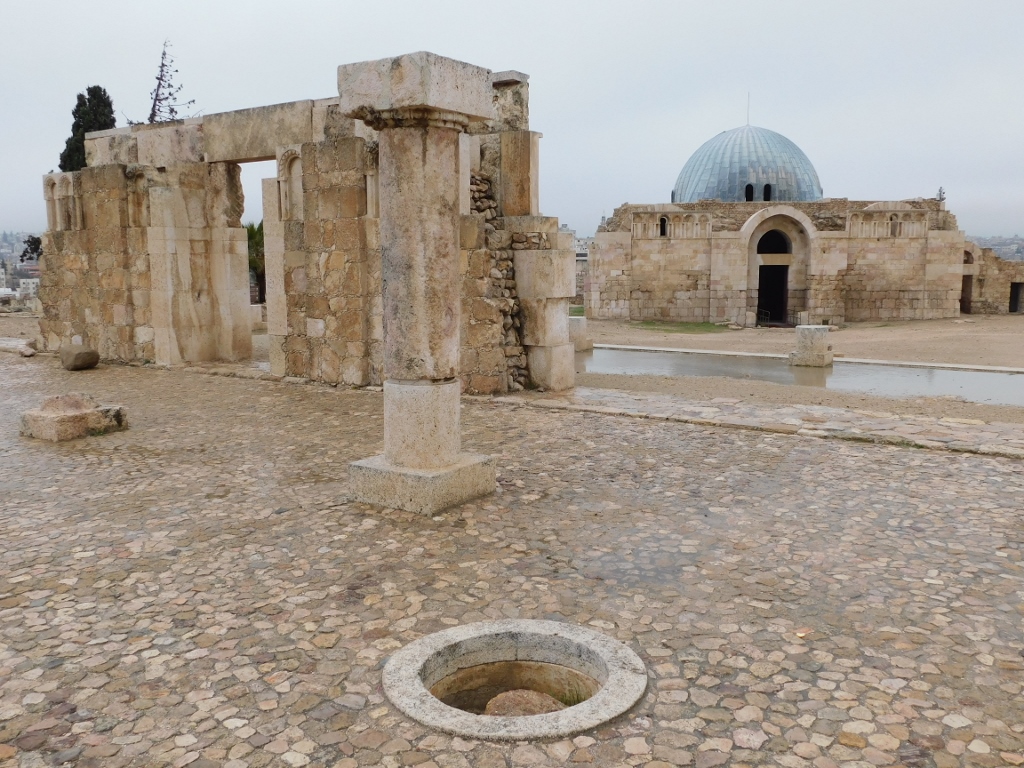 View from the “interior” of the former Umayyad mosque
View from the “interior” of the former Umayyad mosque
You can certainly see the plinths of the pillars that carried the structure of the mosque, while in the very centre there was the courtyard. In addition to these parts of the mosque I’m mentioning, the following photo also shows a little farther, near the cypresses, a part of the Archaeological Museum.
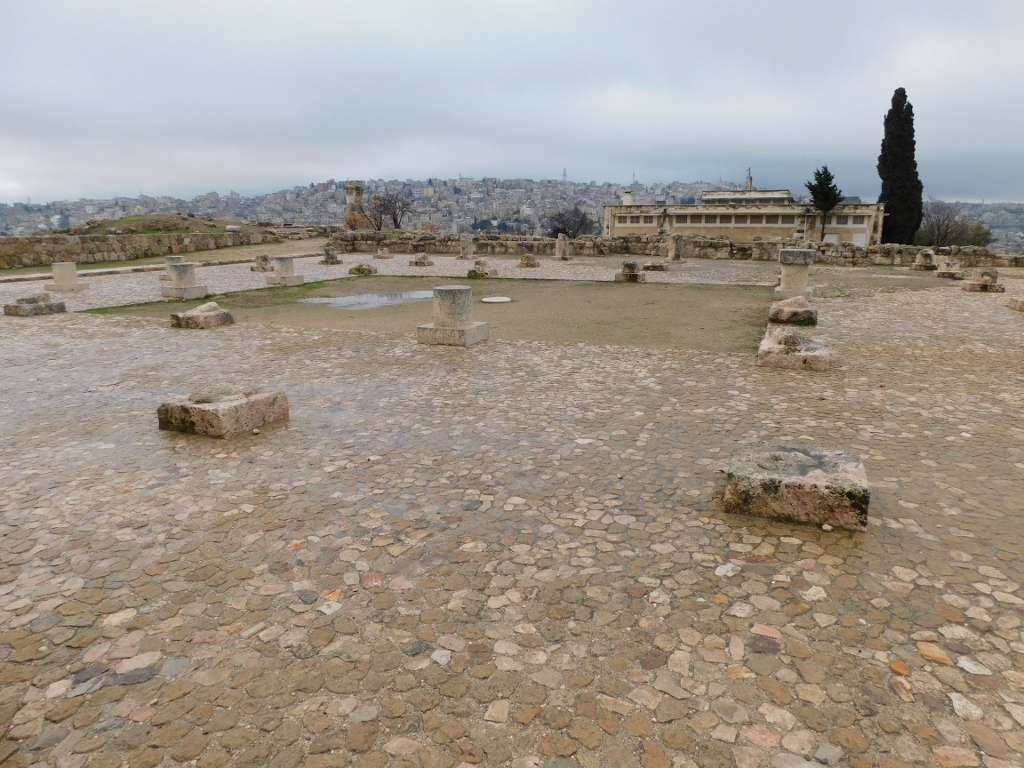 The “interior” space of the former Umayyad mosque
The “interior” space of the former Umayyad mosque
Since the mosque is located on the highest part of the hill, I walked around a little in order to see some other parts of the Citadel from there.
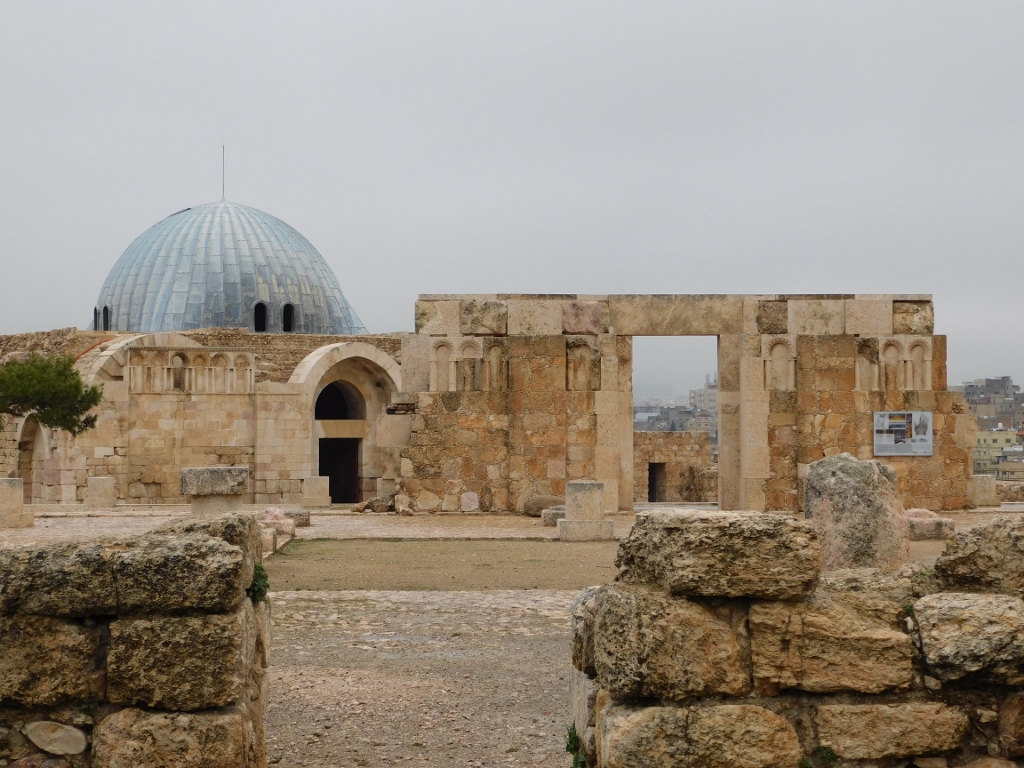 Monumental Gateway and the surviving wall of the mosque seen from the “interior” side
Monumental Gateway and the surviving wall of the mosque seen from the “interior” side
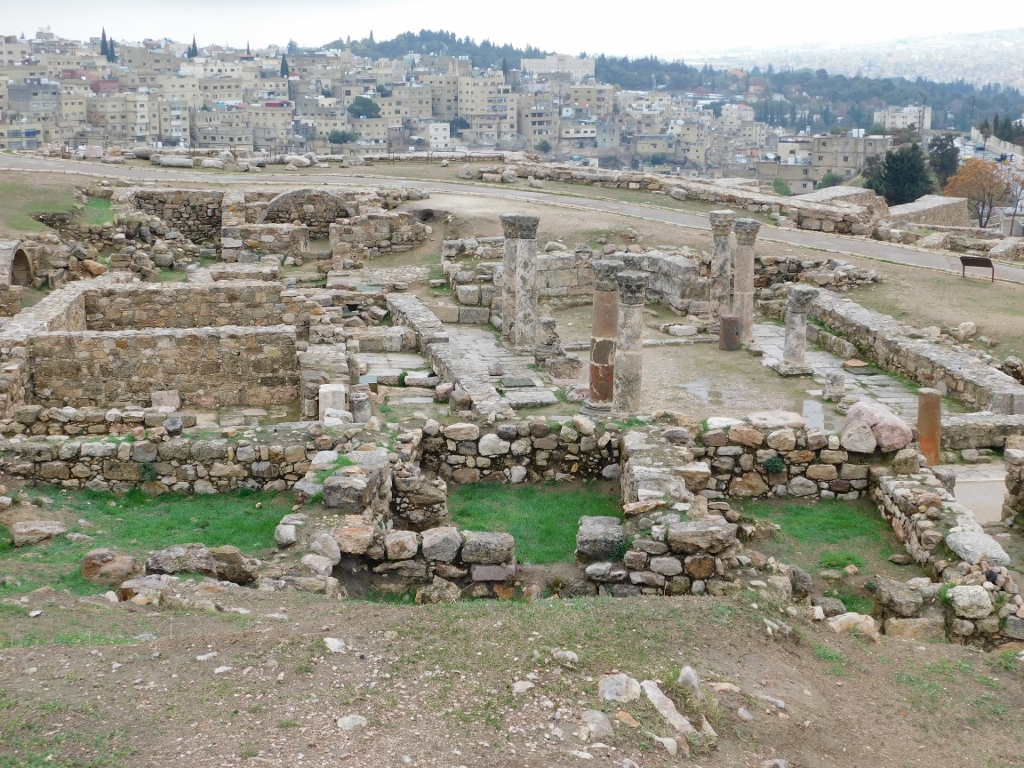 View at the Byzantine church from a higher ground
View at the Byzantine church from a higher ground
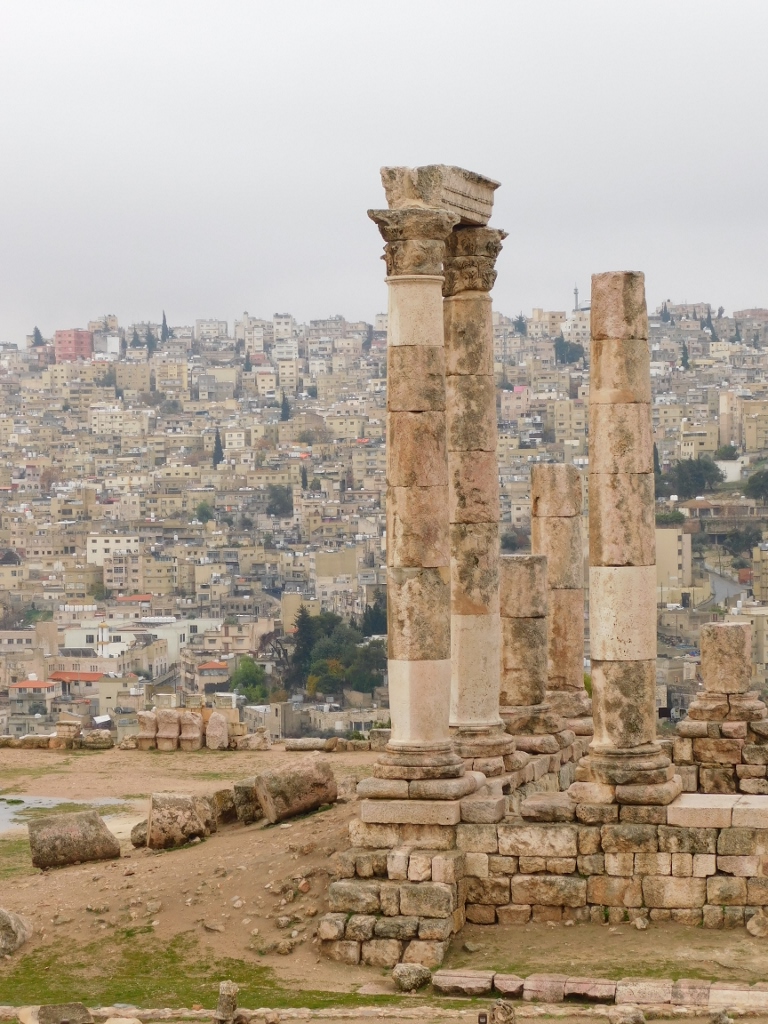 View at the Temple of Hercules and parts of contemporary Amman
View at the Temple of Hercules and parts of contemporary Amman
After this, I went to the Archaeological Museum built here in 1951. I thought this was the right moment since it was starting to rain once again. The museum is nice and, as usual, I mostly looked at the pottery display, since I do pottery as a hobby so I always search for inspiration. But, the museum also holds some very impressive statues and other artefacts, which certainly makes it worth the visit.
Although I hoped it would stop raining while I was visiting the museum, this was not the case. The rain drops were not big, quite contrary, it was more of a drizzle, but there was also a strong wind. Taking into account that an umbrella would not help me much under the circumstances, over a (warm) jacket with no hood, I put another, wind-jacket, with a hood that I brought to Jordan thinking it would be warm enough to wear that jacket alone. How wrong I was! But, at least I was lucky to have the two jackets.